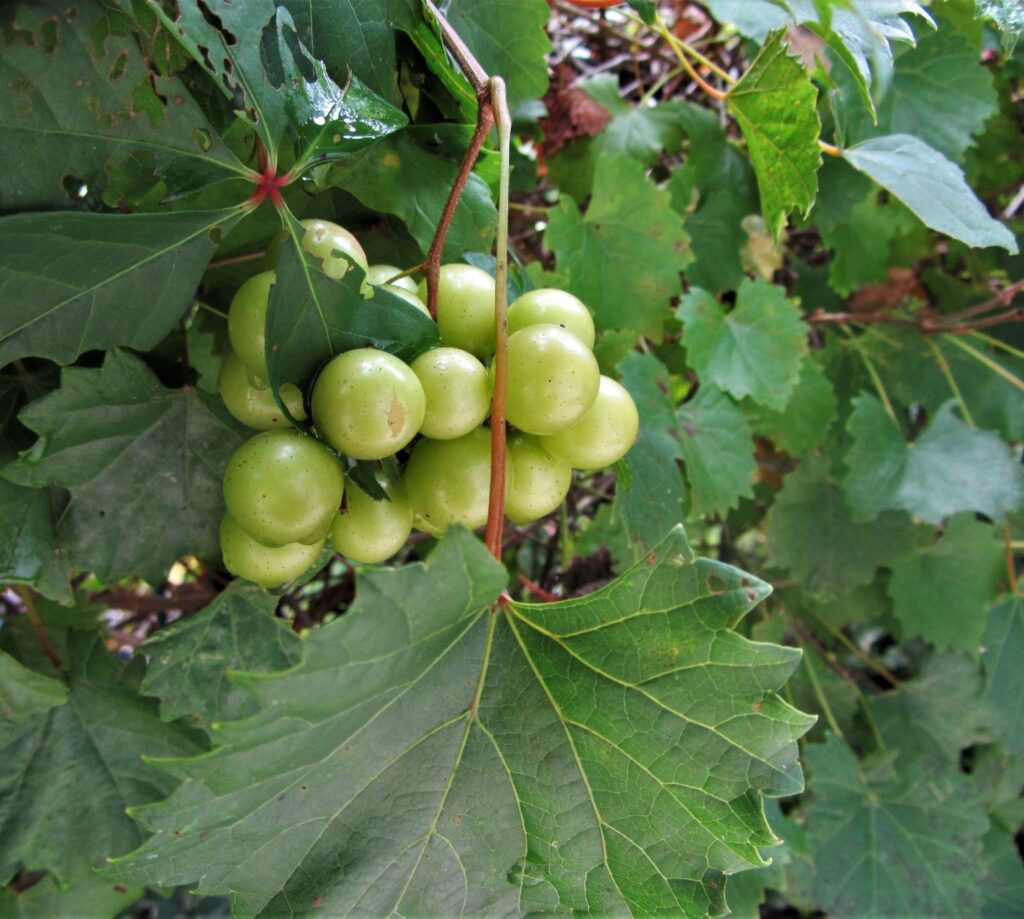Foraging for Autumn Harvests
Have you ever noticed how the strawberries you pick yourself on a warm May afternoon taste much better than the huge red berries you buy at the grocery store? Everyone who has grown their own tomatoes, lettuce, or apples knows how much better homegrown food can taste. You still need to be selective about what seeds you buy because some varieties of carrots and squash taste better than others, and some prove more resistant to disease.
Putting in a summer garden or planting an orchard requires planning, perseverance, and more than a little skill to successfully make the journey from seed to skillet. How much easier to simply wander around the woods, along a riverbank, or even through your own yard to harvest tasty, nutritious foods?
My generation eats mostly from restaurants and supermarkets. But my mother’s family hunted, fished, and raised their own meat and eggs. They grew a garden, and she could point out teaberry twigs, honeysuckle flowers, and wild berries as tastes from her West Virginia childhood. She enjoyed delicious meals and treasured fond memories from those times.
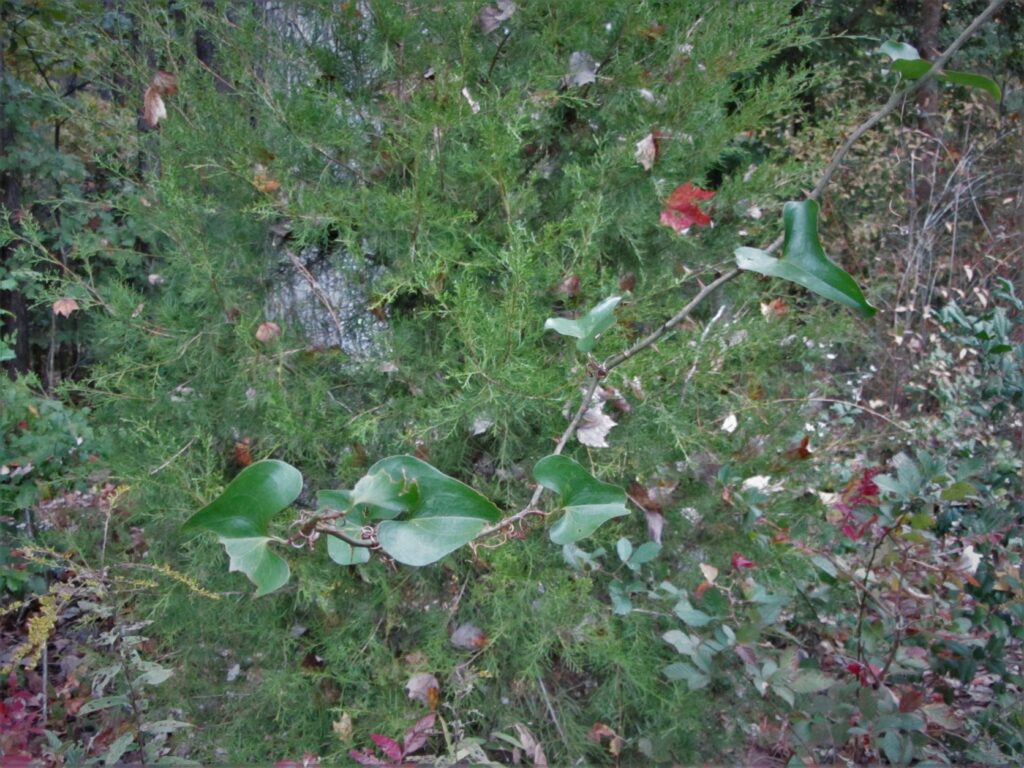
The greenbrier vine has edible shoots and leaves. Tea may be made from goldenrod flowers and juniper leaves.
Recognizing Wild Foods
What our ancestors recognized as good food, many of us disregard as a part of the landscape. I still remember filling my bike basket with wild blackberries from the edge of the woods and bringing them home to Mother for pies and jam. We had an heirloom apple tree that bore tart green apples from late June to September, and we always feasted on apple pies and put-up applesauce for the winter.

Blackberries and dewberries, Rubus species, ripen in June and July, but it is smart to notice where they grow year round.
We are surrounded by delicious food here in Virginia, even in the fall and winter. Whether we choose to feast on it, or not, it is good to know what is edible, when and how to use it. Each season has its own offerings. During the autumn we have a variety of nuts, fruit, berries, Alliums, and greens waiting for us to harvest them. Fungi are another matter entirely. It requires expert guidance to know which are good and which are potentially poisonous, and so they are beyond the scope of this discussion.
Safety First
Of course, there are many look-alikes in the plant world, too. It is important to make a positive identification before harvesting wild food. Look for several characteristic features of the plant. A field guide is essential for beginners who don’t already know the local flora. Sometimes tasty looking fruits, like pokeweed, are dangerously poisonous.
Try any new food in small quantities at first, to learn whether it agrees with you. Be especially cautious with children. Understand that some wild foods can be used medicinally, and that they can impact your health for better or for worse. Without any guidance on how much plant material to use in a preparation, begin with a small quantity and adjust the amount through experience or with the guidance of someone who is experienced in using that plant.
Eat foraged food at your own risk. This author, JCCW Master Gardeners, and the VCE do not accept any responsibility for stomach upsets or other misadventures caused by ingesting plants you find in the wild.
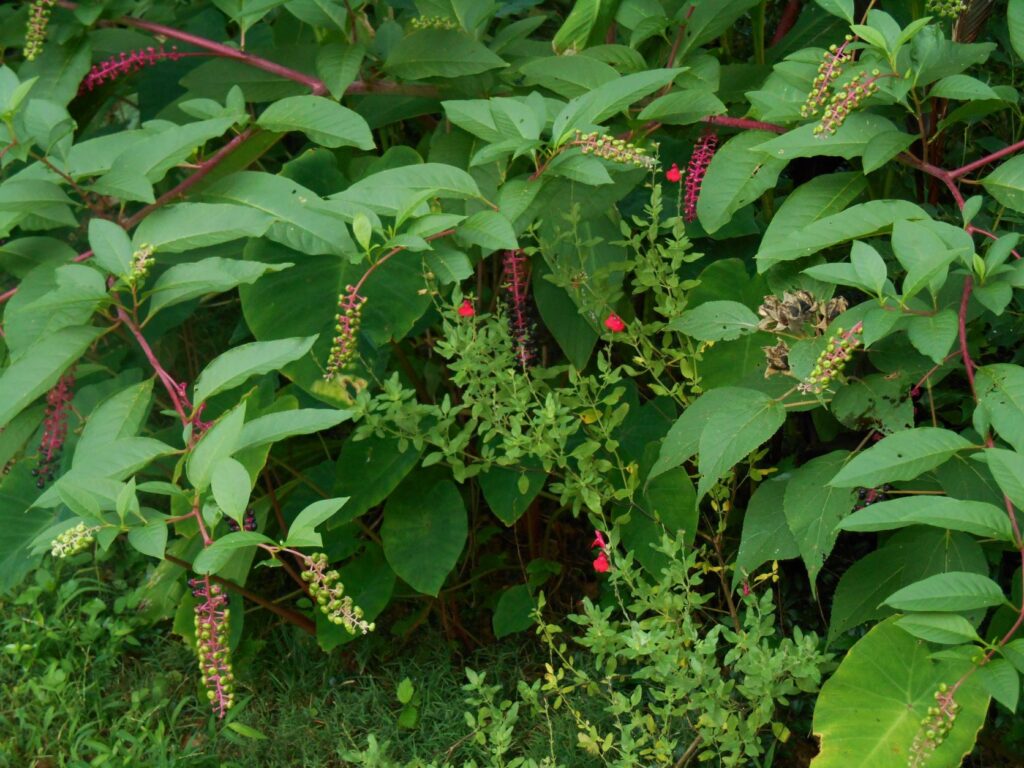
Learn to recognize dangerous plants, like American pokeweed, Phytolacca americana, before foraging. The berries look tasty, but all parts of the plant are poisonous.
One must also respect private property and have permission before foraging on private land. State and national parks often prohibit foraging, though some city and county parks have begun planting fruit and nut trees to benefit their communities. Check on each park’s policies beforehand.
Dress appropriately to stay warm and dry, and to protect yourself from injury while foraging in the woods and overgrown areas. Bring along a variety of containers to hold your harvest and basic tools like a small shovel for roots, a knife and secateurs.
Another consideration is potential pollution in the area where wild food grows. Roadsides, polluted waterways, and land used for industrial waste may have heavy metal, and other pollutants. Several edible plants, like cattails, can also help filter out pollutants and sequester them in their tissues. But we wouldn’t want to eat them if there is the possibility of contamination. Check out an area carefully before gathering wild foods there.
When foraging from a wild population, we must also consider whether we have left enough for the plants to regenerate. We don’t want to completely kill a population, even if we must harvest the roots of a plant. An exception is when we’re harvesting potentially invasive, non-native plants like dandelions or autumn olive drupes. Fruits, like apples and persimmons can be harvested heavily, unless you choose to leave some for the wildlife who eat them, too.
Here are a few of the tasty treats available from September to December in the Williamsburg area:
Fruits
Callicarpa americana, Beautyberry A visitor to the Williamsburg Botanical Garden asked me, a few years ago, whether he could eat the beautyberries. I’d never thought about it. He had read somewhere that beautyberries are edible and wanted a taste.
Not only are beautyberries edible, they also have several medicinal uses. They just aren’t very tasty, because they are very small and quite tart. Boil them into a syrup with sugar or use them to make jelly. Leaves, roots, stems and berries all are edible and have various uses. Crushed leaves contain compounds that repel mosquitoes.
Diospyros virginiana I’ve had an eye on a mystery sapling in my yard for a few years now. It was broken off pretty badly in a storm, and I just couldn’t find enough clues to identify it. Until the other day I was sitting under the deck and noticed the first crop of fruits dangling from its branches; orange, rather wrinkled fruits. American persimmon, of course. Its bright yellow leaves should have been my first clue.
Persimmons are edible right now, though they are sweeter after frost. Eat the fruits fresh out of hand, cut into salads and desserts, or preserved. As with so many wild foods, timing is everything to harvest when foods are ripe, and before the squirrels and birds harvest them for you.
Since persimmons are dioecious, you will need to find or plant a female tree to enjoy the fruit. Native Americans had medicinal uses for the inner bark and unripe fruit, as well as many uses for the ripened fruit.
Malus species Apples are native throughout the Northern Hemisphere. Members of the Roseaceae family, along with hawthorns and crabapples, there are many heirloom apple trees around Virginia in addition to the more modern cultivars. They grow in surprising places. Often the tastiest apples are the least appealing to the eye. Some can be eaten out of hand, others benefit from cooking or juicing to make them palatable.
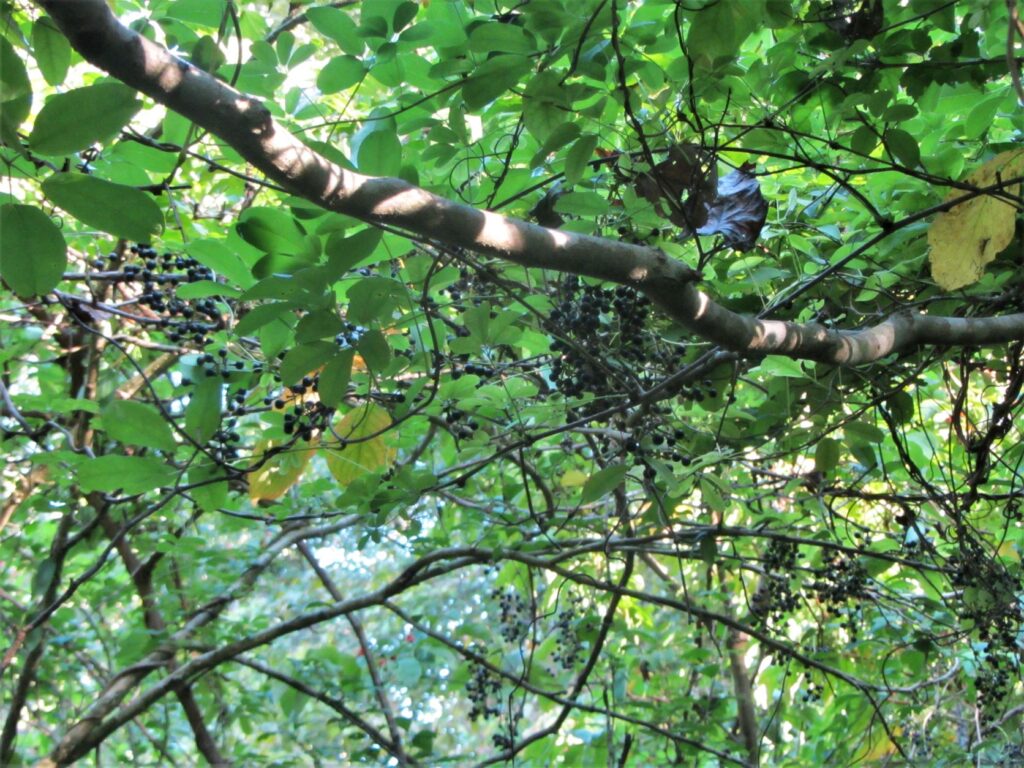
Wild grapes should be identified by looking at their woody vine, their tendrils, and their lobed leaves.
Vitis species Wild grapes grow prolifically in the woods and along roadsides, but you may not have ever eaten one. Birds, and other animals will harvest grapes before they get ripe enough for our taste. Muscadine grapes, Vitis rotundifolia can be bought from farm stands and country markets. They are easy to grow from seeds and bear reliably each year. This native grape was used in many ways by native Americans.
V. vulpina, the fox grape, is a smaller grape that grows in clusters as the vine winds its way through trees and along fences. V. aestivalis, summer grape, is native to Europe but has naturalized in our area. Grape leaves are also edible and may be used for wrapping small packages of food before baking or steaming. Look for lobed green leaves in a variety of shapes, between 2” and 5” wide. Gather grapes for juice and preserves as well as for eating fresh. Look for woody vines, tendrils, and fruits with two or more woody seeds for positive identification of a wild grape. The tendrils are also edible in the summer, when they are tender and green.
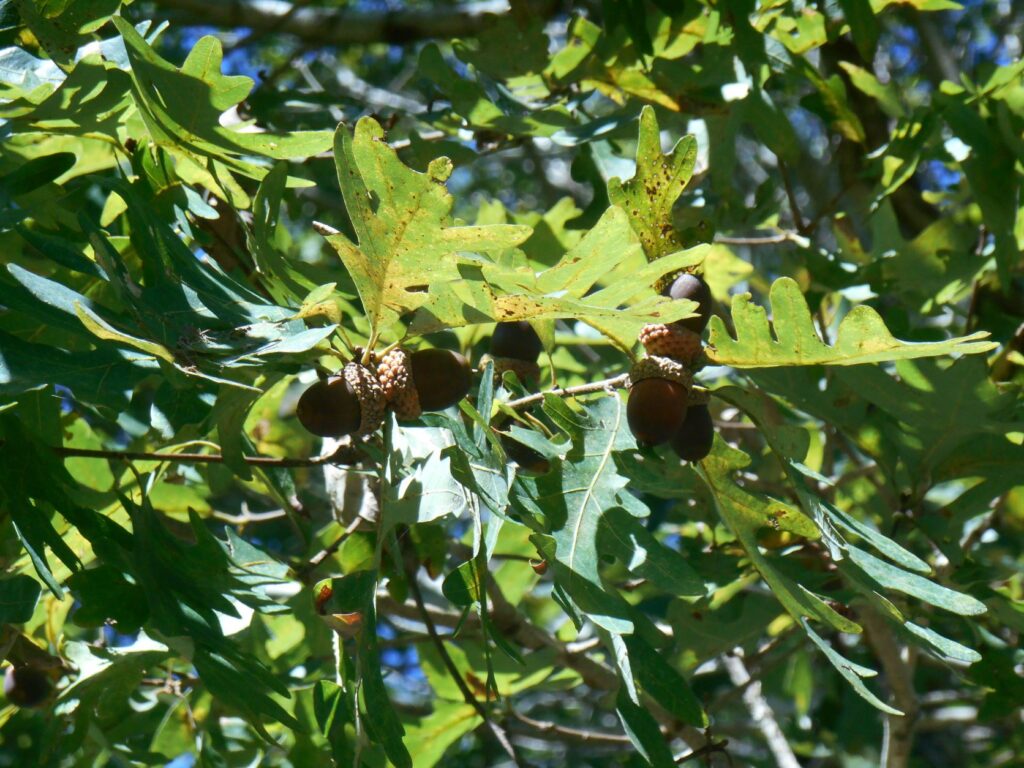
Acorns on white oak trees ripen within a year. White oaks have rounded lobes on their leaves. Remove the caps and shells before soaking the nuts to remove bitter tannins.
Nuts
Many of our native trees produce edible nuts that are all high in protein, minerals and fiber. We are all familiar with pecans, walnuts, hazelnuts, and possibly butternuts, a walnut relative, and hickory nuts. We know to gather these nuts, still in their heavy husks, when they fall from the tree in autumn. They can be found in the woods, in open fields, and around old farms and homesteads.
We need to remove the husk, often a challenge, and then crack open the shell to reach the savory nut meat inside. Most of these nuts are better after they are baked or roasted, but they can also be eaten raw.
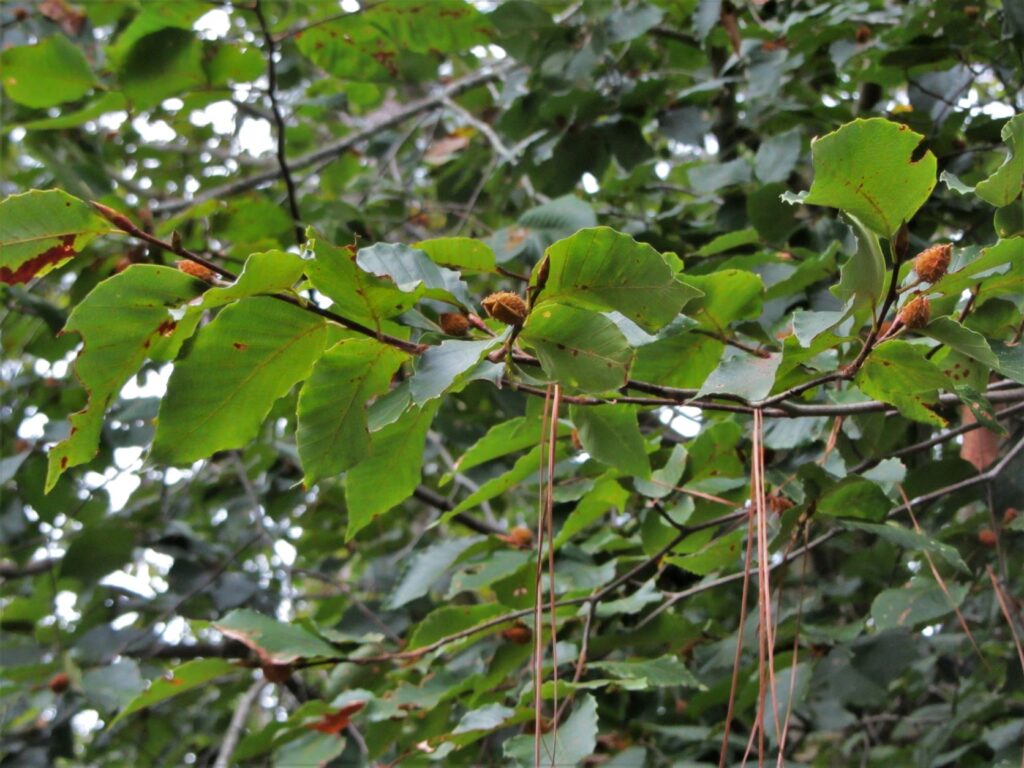
Collect and eat Fagus grandifolia, American beech seeds when they are fresh, as soon as their shells crack open.
We may not be as familiar with eating beech nuts, chinquapins, or acorns. Early settlers in North America soon learned the value of the native chestnut trees, now almost extinct, for the delicious nuts and strong wood. A chestnut relative, Castanea pumila, the Allegheny chinquapin, is a shrubby, multi-stemmed tree that also produces edible nuts.
The American beech tree, Fagus grandifolia, produces edible, but very small nuts. The bur covered outer casings are just opening now, and you may find them on lower branches of the tree still harboring several small nuts. These small shells must be removed to retrieve the nutmeat, which is about the size of a pine nut.
Quercus species Acorns were a traditional vegetable protein of our indigenous ancestors in Virginia, but using the nut takes time and effort because of the tannins in oak. First, inspect the acorns for tiny holes that indicate insect damage, then rinse them in a pan of water and discard any acorns that float. The acorns must be capped, shelled, and then boiled or soaked to make them edible. It can take several soakings until the water runs clear enough to use the nuts. Acorns may be baked or roasted. They can also be ground up into nut meal, which is dried, and then used like other nut flours in baking. Store prepared acorns or acorn meal in the freezer to preserve freshness. White oak, Quercus alba, produces a particularly large and tasty acorn.

Drupes of winged sumac, Rhus copallinum, may be dried and used as a spice, or infused in water as a beverage rich in Vitamin C.
Flavorings
Allium species Wild onions and garlic are edible. You may have field garlic, Allium vineale, growing through your lawn right now. They look like chives, taste like onion, and bulbs, flowers and leaves are edible in small quantities. You may find ramps A. tricoccum in the spring; and wild onions, A.canadense, which can also be found in open fields, from fall into the spring. These are more pungent than commercial onions and may be used fresh, pickled, or cooked. Native Americans also used them medicinally, particularly for coughs. Check for a strong onion or garlic fragrance, because no poisonous plants in our area smell like onions.
Garlic chives, native to Asia, naturalize easily in our area. Their seed heads remain standing in the fall, signaling where to dig for their tasty bulbs. Leaves also remain edible deep into the autumn.

Garlic chives, A. tuberosum
Queen Anne’s Lace seeds, from Daucus carrota, or wild carrot, may be used green or dried as you might use fennel seeds or coriander. Gather seeds from late summer through the winter. Flowers may be battered and fried or preserved in simple syrup with lemon slices for use in beverages. All parts of the plant are edible, but roots and leaves are better from first year plants, before flowers are produced in the second year. Use roots cooked or dried and powdered. Leaves may be eaten fresh or cooked.
Sumac berries Most Rhus species have edible berries, high in Vitamin C. Look for smooth sumac, R. glabra, winged sumac, R.copalinum, and staghorn sumac, R. typhina, with their tight clusters of reddish brown berries held on the tips of their branches. Berries may be dried and ground into powder to use as a spice. Staghorn sumac berries are soaked in cold water to make an infusion to drink like lemonade, or to use in cooking.
Be cautious to avoid poison sumac, Toxicodendron vernix, which has white berries and compound leaves with 7-13 leaflets. All parts of the plant are poisonous to the touch, and to ingest. It contains the same toxin as poison ivy.
Common Juniper, Juniperus communis, also has edible berries that may be eaten fresh or dried. Use them in infusions, or dry and crush them to use as a spice, like pepper, in cooking. Juniper wood may be used to smoke meat. Juniper twigs and leaves may also be boiled to make tea. Use Juniper berries in small quantities, as large quantities can be toxic.
Eastern red cedar leaves, J. virginiana, may also be boiled to make tea. Use the fragrant wood for barbecues and to smoke meat. Use in small quantities, as this is a slightly poisonous plant.
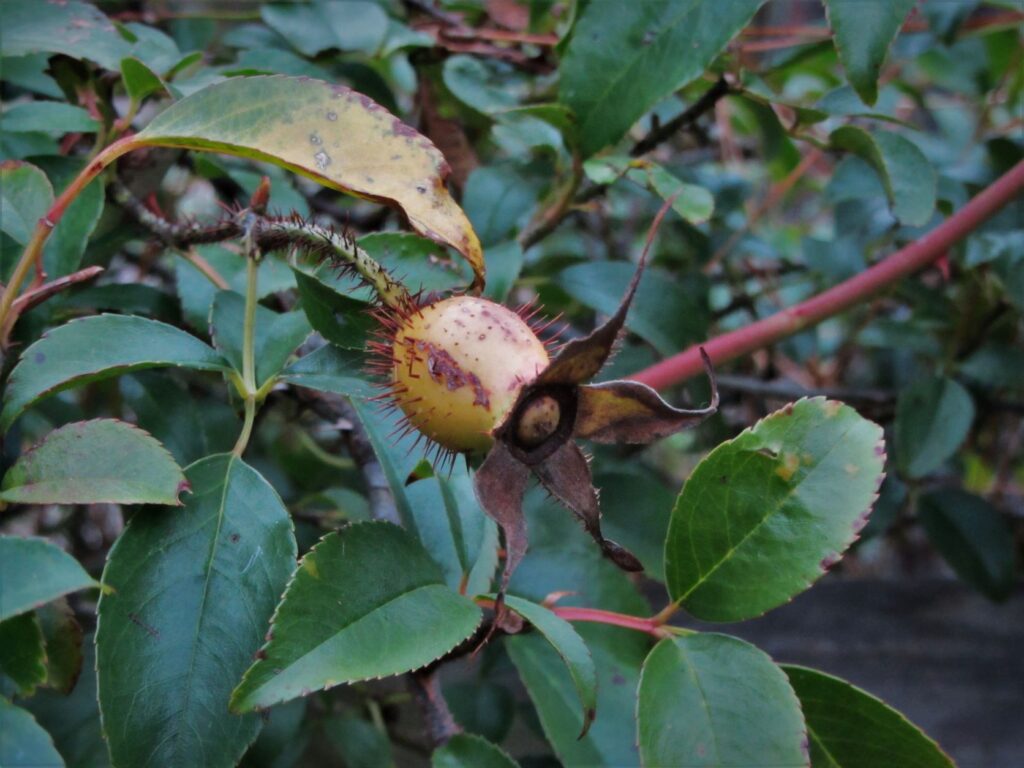
Rose hips grow after the petals fall. Here Cherokee Rose, R. laviegata, isn’t quite ripe enough to harvest.
Rose hips, from Rosa species, are rich in vitamin C. They turn red when ripe in late fall. Cut them from the plant, then prepare them by cutting them in half and removing the seeds. Rose hips may be used in tea, vinegar, jellies, and other infusions. Rugosa roses are known for their large rose hips. You may also gather the seed pods of summer roses from other native and multiflora roses. Fresh rose petals are edible, but insure they haven’t been sprayed with any fungicides or insecticides before eating them.
Virginia Pine Needles from Pinus virginiana, which has pairs of rather twisted needles, may be used in a variety of ways. These pine needles are very fragrant and citrusy, particularly from fall until mid-spring. Make tea from the needles, which are very high in Vitamin C, to soothe coughs. Use the needles to infuse their flavor in other liquids, under roasting meats, or chopped as an herb like rosemary. New buds are also edible, and pine pollen may be used like saffron when cooking, to give a golden color to dough and other foods. Use pine cautiously in small amounts, and pregnant ladies should avoid pine needles, buds and pollen altogether.
Sassafras albidum, also known as cinnamon wood, has been used by Indigenous Americans and early settlers for various medicinal purposes. Its distinctive, mitten shaped, or goose-foot shaped leaves make it easy to identify even before smelling its bark. Traditionally, roots are used for making tea, and have been used in making root beer. Wash the root, leaving the bark in place, and boil in water to make an infusion. This flavored infusion is also used to make syrup and sauces. Leaves are dried and used whole like bay leaves in stews, or they may powdered as a thickening agent. This plant has low toxicity, due to its safrole oil content, and has been banned by the FDA since 1979. Use only in small quantities and be aware of related health risks
Greens
Smilax species, greenbriers, and saw greenbriers, grow tenaciously and taunt us with their prickles when we push them aside. These native evergreen vines grow in wooded areas and fields in full to partial sun. Stems, leaves and roots are edible. Steam or stir-fry tender shoots and leaves, use roots for tea or dried and ground as a thickening agent in soups, puddings, breads and cakes. The tea and leaves have a variety of medicinal uses in Native American traditions. There are at least ten species that grow in our area, each with a slightly different leaf and appearance.
And one more tea….
Goldenrod, Solidago species, is in full bloom right now and may be used to make tea. Cut the top 10”-12” off of a stalk and infuse the leaves and flowers in boiling water. Sweeten with honey or maple syrup. The leaves may be dried and saved, but flowers should be used fresh.
There is a whole world of flavor awaiting adventurous foragers. Every season brings its own delights for the palate, as well as for the eyes and other senses. And foraged foods bring a unique depth of flavor and experience one won’t find in a grocery store.
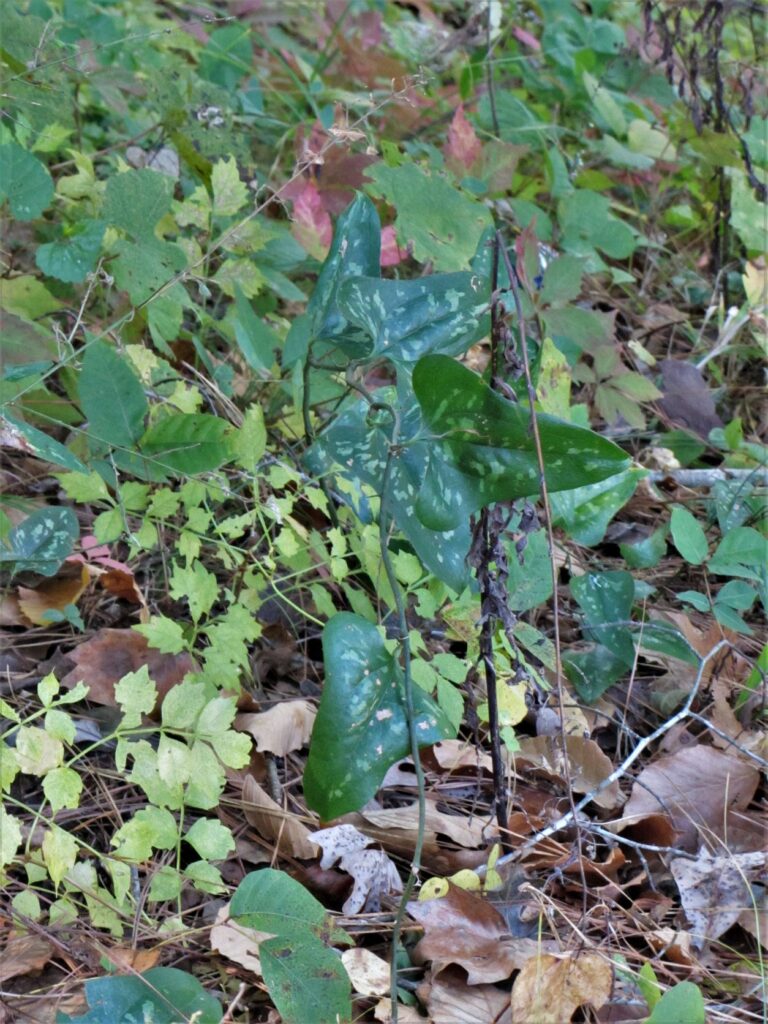
Can you pick out which two of these several vines are edible? Only eat the grape and the greenbrier leaves. Virginia creeper, Parthenocissus quinquefolia, and trumpet vine, Campis radicans, are both poisonous.
All photos by Elizabeth McCoy
Elizabeth McCoy is a JCCW Master Gardener Tree Steward and a former Williamsburg Botanical Garden and Freedom Park Arboretum volunteer.
Appreciation to the WBG & FPA, where many of these photos were taken
For More Information
Bennett, Chris. Southeast Foraging 120 Wild and Flavorful Edibles from Angelica to Wild Plums. Timber Press. 2015.
Elias, Thomas S., and Peter A. Dykeman. Edible Wild Plants: A North American Field Guide. Union Square & Co. 1990.
Monger, Karen. Adventures in Edible Plant Foraging: Finding, Identifying, Harvesting and Preparing Native and invasive Wild Plants. Skyhorse Publishing. 2015.
Peterson, Roger Tory. Edible Wild Plants: Eastern/Central North America (Peterson Field Guides). Mariner Books. 1999.
What is a Weed? (more edible plants)
Planting a ‘Food Forest’ at Home for Sustainable Harvests






